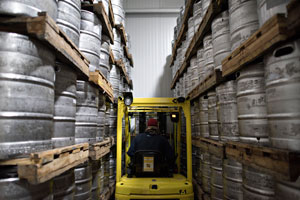Wholesale Prices Show Broad-Based Retreat in April

Wholesale prices in the United States unexpectedly declined in April from the prior month.
The 0.4% drop in the producer-price index followed a 0.2% gain in March that was the first increase in five months, a Labor Department report showed May 14.
The decrease exceeded the lowest estimate of economists surveyed by Bloomberg News. Over the past 12 months, wholesale prices fell 1.3%, the most in records dating to 2010.
Businesses have seen muted wholesale costs as a plunge in energy prices in the second half of 2014 and a stronger dollar boosted by subdued growth abroad limit inflation early in the pipeline. Fed officials are looking for signs that price growth will rise toward their goal as they consider raising rates for the first time in nine years.
“Inflation is still very tame,” said Jim O’Sullivan, chief U.S. economist at High Frequency Economics in Valhalla, New York, whose forecast for an unchanged reading was among the closest in the Bloomberg survey. “If anything, it’s a little weaker.”
The median estimate in a Bloomberg survey of 74 economists called for a 0.1% increase. Projections ranged from a drop of 0.2% to a 0.4% advance.
The year-over-year drop in producer prices followed a 0.8% decline in the 12 months through March.
The report showed fuel costs decreased 2.9% last month, and food expenses fell 0.9%.
The PPI excluding volatile food and fuel prices decreased 0.2% from the prior month, depressed by falling profit margins at wholesalers and retailers. The measure was forecast to rise 0.1% after a 0.2% increase in March.
The core index increased 0.8% in the year ended April after a 0.9% gain.
Eliminating food, energy and trade services, which some economists prefer because it strips out another one of the most volatile components of PPI, costs rose 0.1% last month after a 0.2% advance in March. They climbed 0.7% from April 2014 after a 0.8% gain.
The personal consumption expenditures index, the Fed’s preferred inflation gauge, rose 0.3% in March from a year earlier and has been below the Federal Reserve’s 2% goal since May 2012. The core measure increased 1.3% in the 12 months ending in March.
Fed officials are monitoring inflation and labor-market progress as they debate when to raise the benchmark interest rate for the first time since 2006. The first increase will take place after the policymakers’ meeting in September, according to 73% of economists in an April 22-24 Bloomberg survey.
The producer price index reading is one of three monthly inflation gauges from the Labor Department. The CPI, due for release May 22, rose 0.1% in April, according to the Bloomberg survey median. A report May 13 showed the cost of imported goods fell 0.3% last month, marking the 10th straight decline as the dollar rose overseas economies cooled.

